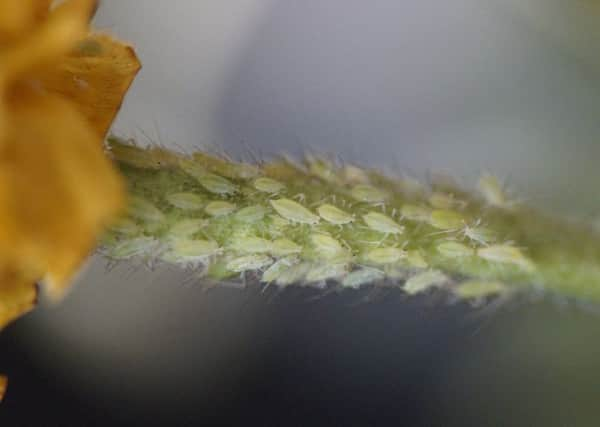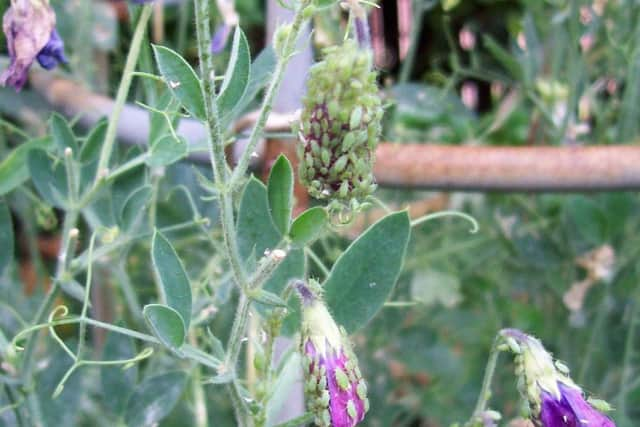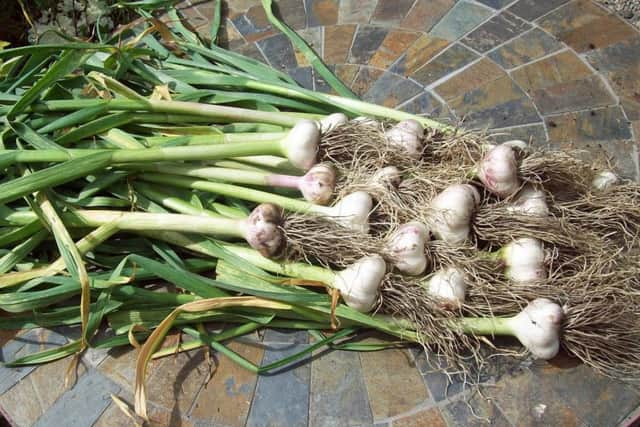Gardening: Act quickly to tackle the explosion in aphid numbers


Aphids are sap-sucking insects, also known as greenfly and blackfly, although they can be yellow, pink, white or mottled. Most feed on foliage, stems and flowers, but some suck sap from roots.
There are more than 500 species in the UK and almost all plants can be affected.


Signs of an infestation include:
Advertisement
Hide AdAdvertisement
Hide Ad* Obvious colonies on shoot tips, flower buds and the underside of younger leaves.
* Stunted growth with curled or distorted leaves, weakening the plant.
* Sticky ‘honeydew’ on plant and surroundings, often with black sooty mould on it.


* White cast skins on the surface of leaves and soil.
The first step is vigilance. Inspect your plants closely at least twice a week and squash any you see. On stronger plants, blast them off with a hose. Killing one or two sends off a chemical signal that warns other aphids to stay away. Ants ‘farm’ and guard aphids to harvest their secreted, sweet honeydew – put sticky traps on tree trunks to prevent ants reaching and safeguarding colonies.
Advertisement
Hide AdAdvertisement
Hide AdAttract predators such as lacewings and ladybirds with mint, fennel, dill, yarrow and clover.
Alliums (the onion family) are said to drive aphids away.
High levels of nitrogen encourage weak, sappy growth which aphids love to feed off. Prevent this by using slow-release organic fertiliser to avoid a nitrogen spike.
Use yellow sticky traps to capture flying aphids and monitor their arrival.
Archaic plant remedies*:
:: A solution of chopped elder leaves, soap and water works well on infestations of plums and greengages.
Advertisement
Hide AdAdvertisement
Hide Ad:: A similar solution of rhubarb leaves, which contain oxalic acid, is also recommended.
:: Burning of laurel leaves in a greenhouse is supposed to kill aphids, thrips and red spider mite.
*From The Gardener’s Folklore, Margaret Baker, published by David & Charles, 1977.
Garlic oil
Garlic contains sulphur, which is toxic to pests and is an antibacterial and antifungal agent.
The soap also breaks down the bodies of soft-bodied pests.
Advertisement
Hide AdAdvertisement
Hide AdTake three to four cloves of garlic, mince them and add two teaspoons of rapeseed oil. Leave for 24 hours.
Sieve out the garlic, and add the liquid to one pint of water. Add one teaspoon of liquid dish soap/Fairy liquid. This mixture can be stored and diluted.
When you need to spray, use two tablespoons of the mixture added to one pint of water in a spray bottle.
To use, test by spraying an inconspicuous part of the plant to see if your mixture harms it. If there are no signs of damage after a day or two, it is safe to use.
If there is leaf damage, dilute and try the test again.
Advertisement
Hide AdAdvertisement
Hide AdWarning: Garlic oil is a non-selective insecticide, which means that it will kill beneficial insects as well.
GET IN TOUCH
l For more information, plus cook what you grow, recipes, environmental news and more, log on to the website at www.mandycanudigit.com – which is also now smartphone friendly.
You can also follow Mandy on Twitter @MandyCanUDigIt or you can like me on my Facebook page at Mandycanudigit
JOBS TO DO AT THE WEEKEND
Sow cauliflower, purple sprouting broccoli, and winter bedding plants.
Advertisement
Hide AdAdvertisement
Hide AdContinue hardening off annuals grown under glass but have horticultural fleece handy for colder nights.
Spreading and trailing plants such as Alyssum and Aubrieta, can become tatty, so trim them back after flowering.
Put supports in place for herbaceous plants for those like peonies with heavy blooms.
Lift clumps of forget-me-not once the display wanes, and before too many seeds are released.
Advertisement
Hide AdAdvertisement
Hide AdPinch out leading shoots on plants such as Chrysanthemum and Helianthus to encourage bushy plants.
Pot on root-bound plants.
Tie in climbing and rambling roses as near to horizontal as possible, to restrict sap flow, causing more side-shoots to grow along the stem, producing more flowers.
Put netting in place to protect all soft fruit from birds.
Earth up potatoes when the shoots are 23cm (9in) high, in order to prevent the new tubers going green, leaving 5cm (2in) of shoot uncovered so that the plant has enough foliage to continue growing.